TRIAC is often used as a means of light dimming in domestic lighting applications, and can even serve as a power control in motors.
To find out more about TRIAC control for LEDs, check out our new blog below.
Why choose TRIAC?
TRIAC’s ability to switch high voltages makes it an ideal choice for use in diverse electrical control applications. This means it can work to suit everyday lighting-control needs. TRIAC circuits are used for more than just domestic lighting though, they are also utilised when controlling fans and small motors, and also in other AC switching and control applications.
If you are looking for a multipurpose control, we are sure you will find TRIAC to be a very useful protocol.
What does TRIAC mean?
TRIAC stands for Triode for Alternating Current, and is a switch that is used to control power. When used in lighting applications, it’s commonly referred to as ‘TRIAC dimming’.
How do you control TRIAC?
TRIAC control works via a gate electrode when a positive or negative voltage is applied.
Triggering the circuit allows conduction of electricity until the current falls below the intended threshold. In this case, a TRIAC allows for high voltage to pass through with very small control currents.
Using phase control, a TRIAC can control the percentage of current that flows through a circuit load.
What is a TRIAC controller?
A TRIAC controller acts as a high-speed switch, and is used in controlling the amount of electrical energy that goes through a bulb. It usually has a trigger which dictates when electricity can be conducted and reduces the voltage to avoid the energy being supplied to go overboard.
A TRIAC control for LEDs works by regulating the intensity of light: when the switch reacts, less power is conducted and the bulb dims.
What is a TRIAC receiver?
A TRIAC receiver uses similar concepts to the simpler thyristor. It is a sensitive gate with a 200V blocking voltage.
What is a TRIAC-dimmable power supply?
This is a dimmable voltage LED driver, designed to operate with a triac dimmer switch. It is available with an aluminium casing.
This type of power supply is a great choice for straightforward control of tape lights and LED fixtures, as well as under-cabinet lights and other applications.
Discover InStyle’s full range of dimmable LED power supplies in our TRIAC dimming product catalogue – click here!
Is TRIAC mains (~230v) dimming?
Yes, it is! Wiring a TRIAC module to your mains supply (between 100-240v AC), you will be able to get the dimming effect you require.
How do you wire a TRIAC LED control system?
It can be challenging to wire TRIAC dimmers to LED drivers, so here is a breakdown of how to go about the task. The most common dimmer is the standard forward phase dimmer: it comprises a TRIAC and a resistance circuit. Resistance is controlled by a potentiometer, and the RC time then controls the amount of delay created before a TRIAC turns on which is also the firing angle.
The period of time when the TRIAC is on (active) is referred to as a ‘conduction angle’. This results in a voltage waveform which is a phase-cut sine wave (a ‘sinusoid’). A standard switching converter is used in regulating the output with no limits on the input voltage. In this case, the phase-chopped waveform provided by the phase dimmer is decoded first; the decoded info is used in controlling the reference for output regulation.
‘Leading edge’ dimmers make use of a TRIAC switch in controlling power while ‘trailing edge’ dimmers use MOSFETs or IBGTs to control power. So it is important to ensure that your phase-cut dimmable LED driver is compatible with the dimmer switch you will be using before you can make any purchase.
How do I wire a TRIAC power supply?
Positive or even negative gate current is used as a trigger regardless of the polarity of the MT2 which leads to four trigger modes. You experience a greater current sensitivity when you have MT2 and gate currents on the same polarity, either as both negatives or both positives.
Can I control other lighting using the same TRIAC controller/dimmer? – for example, LED lights and other things?
To answer your question, yes you can!
A TRIAC controller provides efficiency and permanence. It works by reducing and rectifying the 120AC to a 12/24V DC signal, which is compatible with LED strips. And also by interpreting data signals and translating the instructions to the LED strip.
Can TRIAC work with home automation systems such as Lutron and KNX?
Definitely! TRIAC works with both systems to provide you with efficient home lighting!
What cable do I use for TRIAC power supplies?
A python power cable is best suited for use with TRIAC power supplies, as it allows for DC sensors to be installed in places where there is AC power.
What TRIAC control does InStyle LED offer?
At InStyle, we can meet your needs and offer you a range of quality TRIAC controls.
We have a 10-Watt TRIAC LED driver, which is a high-quality dimmable 12-volt LED power supply. We also offer a TRIAC LED dimmer module – a single-channel receiver which can control 12v or 24v lighting.
What is ‘leading edge’?
These are switches that were originally used in dimming incandescent and halogen bulbs. Commonly referred to as a TRIAC dimmer and commonly used in dimming controls. A good example is a BG screwless 1-gang 2-way 400W dimmer.
What is ‘trailing edge’?
This is a little more sophisticated, in comparison to leading-edge dimmers. Trailing edge dimmers have a lower minimum load, and are ideal for low-powered lighting circuits.
What is the difference between leading-edge and trailing-edge dimmers?
| Leading edge | Trailing edge |
|---|---|
| Cheaper and simpler | More expensive and sophisticated |
| Provide high minimum load | Provide low minimum load |
| Common in use but not in LED lighting circuits | Commonly used in low powered lighting circuits |
What is a ‘dimming curve’?
This refers to how dimmers react to voltage output, as a direct response to input from a control signal. An LED light usually dims in proportion to the input it receives in a linear way, in what is referred to as the ‘dimming curve’.
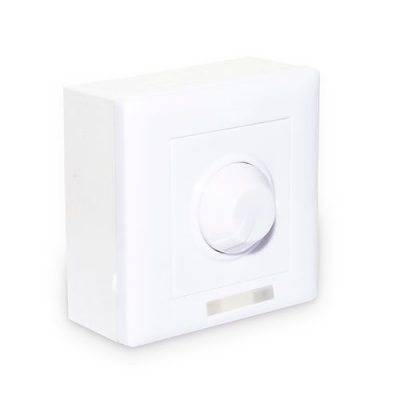
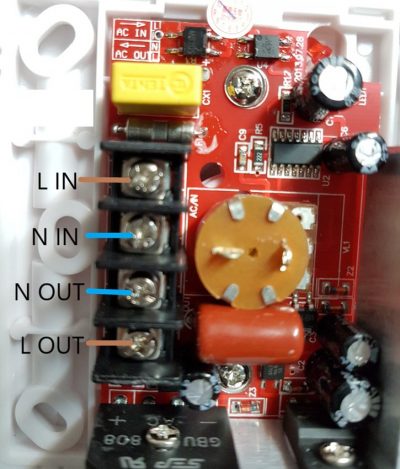



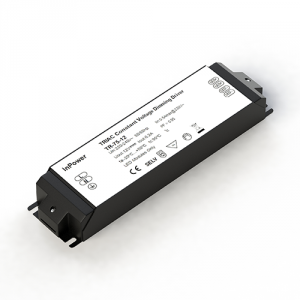
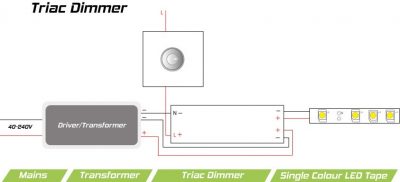
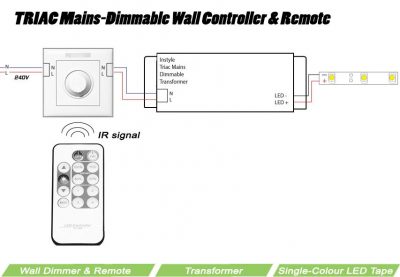
 Setting up your TRIAC transformer
Setting up your TRIAC transformer
